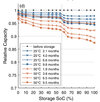Nope.
50% is good, but not really because it is in the middle, its because it is on the right side of the step in calendar aging thats locsted at about 57 to 60%.
Calendar aging for a NCA Lithium ion battery(as used in Long Range model 3 and S/X And earlier model 3 SR) is lower the lower the SOC is. This as long the cell voltage is kept above 2.5V, which the BMS alwsys ensures.
This picture is from one research report, there is very many research reports telling us the same thing. The other picture from another report, telling us the same thing.
If you need to keep the decradstion low, keep the SOC low when the car is not in use. (And keep the battery cool, but thats most often not that easy to achieve).
View attachment 753117
I did follow this advice since my M3P was new one year ago(ODO 32000km now), and I still have full range when charging full.
I have several full charges and 17% Supercharging or so. Those do not hurt even close as much as having 80-90% all nights.
I also have a small benifit from living in a very high latitude( cold climate).



